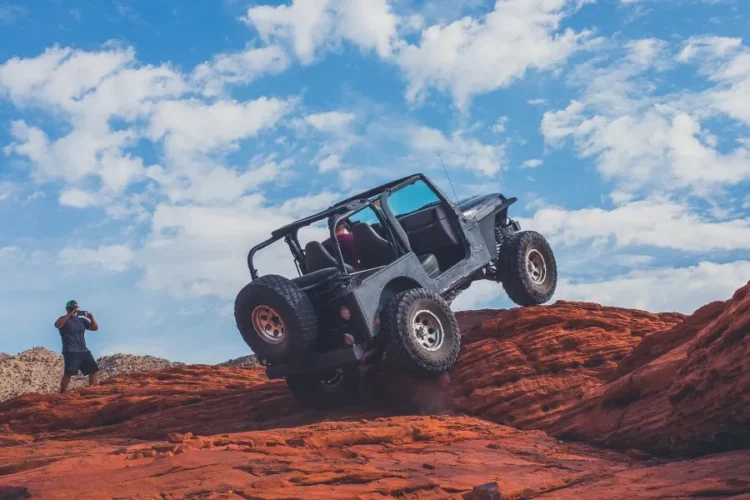Just because you own a Jeep doesn’t mean you must take it off road. However, you’re happy to know you can, and perhaps one day you will. After all, when many people think of Jeeps, they conjure up images of vehicles banging around rocks or boulders or otherwise making their way through dirt or mud. And really, if you want to take your road adventures to another level, you’ll need to occasionally take your tires off the pavement. With that said, here’s Jeep off-roading 101.
Must Haves For Going Off Road
Tires
Speaking of tires, you’ll need the proper ones for your environment. While a mud terrain tire will be noisy on the road, it quickly expels mud, sand, or snow to help you negotiate your way through it.
Or you may opt for all-terrain tires if you expect to come across various types of surfaces, but you don’t plan to do anything that extreme.
Regarding tire size, that will be decided by what fits and easily turns in your Jeep’s wheel wells. Know that you’ll get more ground clearance and contact with bigger tires. However, if your tires are too big, you’ll have to modify your transmission or axles to skirt diminished fuel economy and power loss.
Recovery Equipment
You’ll be glad you have this if, despite having good tires, you still get stuck. You’ll need what are called traction pads to help you through loose terrain, as well as snatch straps so that another vehicle can extract you from a snag. You’ll also need a high-lift jack and base for tire changing on any terrain, as well as a tire patch kit, shovel, work gloves, headlamp, and a jump starter.
Lights
Despite all the offerings out there, all you need are some driving lights with wide enough beams for night driving. You may also want to consider attaching auxiliary driving lights to your front bumper, or mounting spotlights near your door mirrors to illuminate each side of your path ahead.
Emergency Equipment
Keep water and nonperishable foods in your Jeep SUV, along with warm, water-repellant clothing as well as a seatbelt cutter or glass breaker, first-aid kit, and long-distance radio that’s solar powered, or which has a spare battery.
Understand Your Vehicle’s Capabilities
Do you know what all the systems in or on your vehicle can do, and when to employ them? Take traction control, for instance. You may want to deactivate the system when you’re off road so that your vehicle doesn’t employ the brakes at the first sign of traction loss.
If your vehicle has a two-speed transfer case – 4WD Hi and 4WD Lo – you’ll need to know how to use it. If you have permanent 4WD, stay with 4WD Hi unless you need big torque at low speeds (when rock crawling, for instance). That’s when 4 Lo is in order, as is a shift to a lower gear for more torque.
Then there are lock differentials, which can move you through pretty much anything. When you lock a differential, usually via a switch or button, you link the two wheels. This way, if one wheel gets lose, power goes to the one with traction.
Other Things You May Want
You may want to have on board an air compressor to reinflate your tires to standard psi after off roading or after a repaired puncture. You also may want what’s called a snorkel to re-direct your air intake from engine level to a markedly higher position on your ride. This can come in handy when fording water or when you need to pull cleaner air from above a cloud of dust.
Further, if you have a Jeep, you really don’t need any aftermarket suspension to support your vehicle’s weight. But depending on your vehicle and its age and model, etc., talk to the manufacturer for help with getting the proper suspension for you.
So, there you have it, Jeep Off-Roading 101. Know that if you have a Jeep, you’re already ahead of anyone else, when it comes to sheer capability. Apply this extra knowledge, and you’ll be safer and have more fun.







